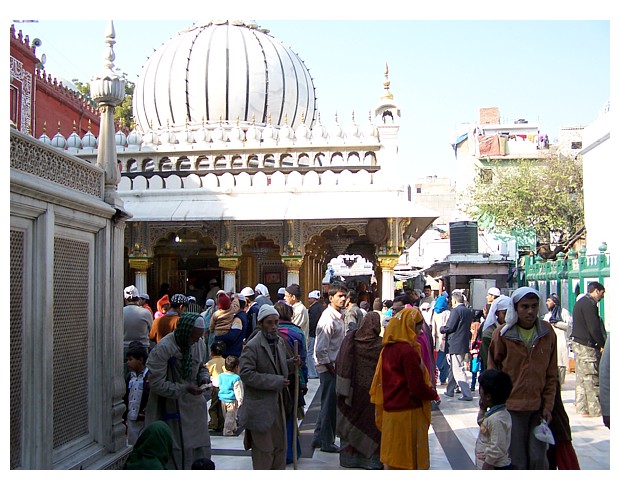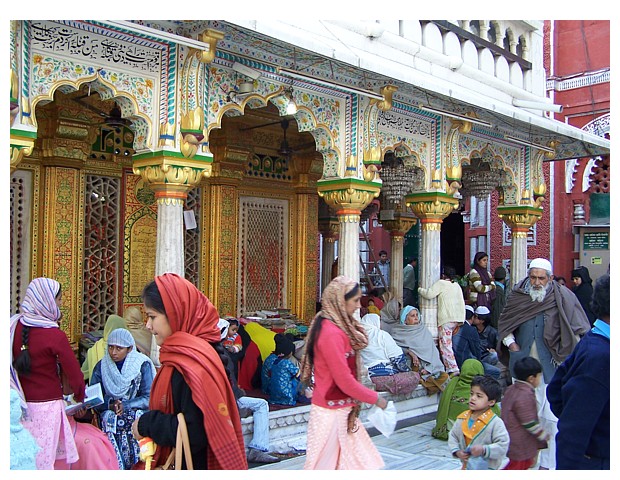1238 में बदायूँ में पैदा हुए निज़ामुद्दीन दिल्ली वकील बनने आये थे पर फ़िर आज के पाकिस्तान में अजोधन नाम की जगह पर रहने वाले चिश्ती संत फरीद्दुदीन के चेले बने और दिल्ली वापस आ कर शहर के बाहर घियासपुर नाम के गाँव में रहने लगे.
आज का शहर से घिया निज़ामुद्दीन का इलाका देख कर ख्वाजा जी के समय की दिल्ली का अंदाज़ लगाना कठिन है. उस समय की दिल्ली कैसी थी? दिल्ली का केंद्र था महरौली जहाँ पर तब कुतुब मीनार नहीं बनी थी और उस जगह पर शायद वह 27 हिंदू और जैन मंदिर थे जिनके बारे में खुशवंत सिंह ने अपने उपन्यास "दिल्ली" में लिखा है. तब न पुराना किला था, न तुगलकाबाद, न चाँदनी चौक और न लाल किला, सब तरफ़ शायद गाँव ही थे. निज़ामुद्दीन जी 88 वर्ष तक जिये और 3 अप्रैल 1325 को उनका देहाँत हुआ. उनके सामने ही 1310 में कुतुब मीनार बनी, उनके सामने 1320 में अलाउद्दीन खिलजी गये और मुहम्मद बिन तुगलक आये जिन्होंने तुगलकाबाद में अपनी नयी दिल्ली बनायी.
दरगाह में क्रब वाले कमरे में स्त्रियों का घुसना मना है और औरतें उस कमरे के बाहर जाली से अंदर देख सकती हैं.
Delhi, India: I had heard about the tomb sufi saint Nizamuddin but I had never been there before. Born in 1238, he wanted to be a lawyer but instead became a desciple of sufi sait of chishti tradition, Faridduddin and settled in Ghiyaspur. Looking at the area today it is difficult to imagine the Delhi of his times. The centre of Delhi in those days was Mehrauli, where the famous Qutab Minaar was still not there and in its place were probably the 27 Hindu and Jain temples described in Khushwant Singh's novel, "Delhi". There was no old fort, Tughlakabad, Chandni Chowk or Red Fort. In his lifetime, Qutab Minaar was built and Tughlak came into power. Women are not allowed inside the room of the tomb and they sit outside, looking in through the marble screen.
Delhi, India: Avevo sentito parlare della tomba di Nizamuddin, santo della tradizione sufi di Delhi, ma non l'avevo mai vista. Nato nel 1238, lui voleva diventare un avvocato, invece diventò il discepolo di Faridduddin, un altro monaco sufi famoso di quell'epoca. Si stabilì al villaggio di Ghiyaspur, fuori della città di Delhi. Se guardiamo la zona oggi, è difficile immaginare quella zona ai suoi tempi. Allora il centro di Delhi era a Mehrauli, dove non avevano ancora costruito il Qutab Minaar e forse al suo posto vi erano i 27 templi indù e gainisti descritti da Khushwant Singh nel suo libro, "Delhi". Non avevano ancora costruito il vecchio forte, non c'era Tughlakabad, ne Chandni Chowk o il forte rosso. Durante la sua vita fu costruito il Qutab Minaar e la dinastia dei Tughlak prese il potere di Delhi nel 1320, mentre il santo morì nel 1325. Le donne non possono entrare nella sala della tomba e stanno fuori intorno alle pareti di marmo intagliato per guardarci dentro.


रोचक जानकारी व सुन्दर तस्वीरें.
ReplyDeleteGreetings! The post is really interesting and kept me engrossed throughout the time. I had my eyes on it and my mind could imagine what is being talked about.- http://www.theconnaught.in/delhi_hotels.html
ReplyDeleteThanks Neha :)
Delete